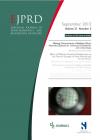European Journal of Prosthodontics and Restorative Dentistry
Book Review - Peri-implantitis.
Abstract
Stefan Renvert and Jean-Louis Giovannoli. Quintessence Publishing. 259 pages, 1197 mostly coloured illustrations. ISBN 978-2-912550-98-9. Hardback £140
With increasing focus at scientific meetings on the topics of aeitiology, diagnosis and management of peri-implant diseases, this book has certainly come in a timely manner. Up until now, these diseases have only generally received recognition in publications or within individual book chapters; subsequently this textbook is a rare occurrence as it is solely devoted to the topic. The book, which is very well presented, is hard backed, 259 pages long, well reproduced and appropriately sized. The title for the front cover has a striking bold colored font, which immediately captures the reader’s attention. The quality of the clinical photographs and schematics throughout the book are of an expected high standard. The forward is by Niklaus Lang for which I can only but echo, in that as dental implants become an ever increasing and popular treatment modality, peri-implant diseases will, and are, unfortunately becoming encountered with increasing frequency. Although the title for the book may not appeal to all, the book is essential reading for all practitioners (general, higher trainee/ post-graduate or current specialist) involved in recommending, undertaking and maintaining implant retained restorations. The authors of the book are two experienced periodontists and implantologists; Stefan Renvert (based in Sweden) and Jean-Louis Giovannoli (based in France) who have been actively involved in clinical, research and educational activities for the last twenty years. They have divided the book into eight chapters, all of which have been appropriately well referenced, and are of an easy to read format. After each subsection in the chapters, bulleted bold summary statements aim to summarize the literature and information presented, thus helping to clarify the sometimes-conflicting evidence. In more detail, chapter one of the book explores the pathogenesis of peri-implant diseases with direct comparisons being made to periodontitis; further attention is given to the microflora, histopathogenesis and local factors that can exacerbate the conditions. Chapter two is dedicated to diagnosis, whereby the importance of continued review and early detection is stressed; a number of diagnostic methods and processes are presented. Excellent illustrations of morphological walled boney defects help to classify the nature of bone loss around single and adjacent implants. It is highlighted how the anatomy of these defects might then impact on potential surgical therapy. Chapter three is a short, concise but important section that focuses on the prevalence of the conditions; it suggests a figure of 80% of patients with implants may show signs of peri-mucositis and after ten years one in five patients can show signs of peri-implantitis. More important yet disappointingly, it was suggested that the scale of the problem in the future might become even more significant. Chapter three follows on to introduce and explore the term ‘early peri-implantitis’ as the presence of an inflammatory lesion of infective aetiology when osseointegration is being established but when the implant is mechanically stable. It also defines the term ‘retrograde peri-implantitis as the presence of a lesion at the apex of the implant. The aeitiology, diagnosis, prevalence and treatment of these further conditions are subsequently presented, with conclusions being drawn that they develop as a result of implants being placed in sites that have been poorly decontaminated. However, it is often possible to preserve the implant/s affected by these conditions with appropriate treatment. The fundamentals of local and general risk indicators are then discussed in detail within chapter five; it is in this section that the reader is informed that although currently there is limited scientific data confirming all the presented factors to be true risk indicators, they should none the less be aware of all putative factors that are likely to be involved with the development of peri-implantitis. Chapter six is the longest section in the book, which looks into treatment options for established peri-implant diseases. This chapter is also the most detailed with regard to the evidence base, with a separate appendix included that reviews current literature (1992-2011) available on treatment procedures. The whole remit of the options available are discussed which include: non-surgical mechanical treatment, local and systemic antibiotics, laser and airborne particle abrasion devices, access surgery, resective surgery, bone grafts, substitutes and barrier membranes. Although all these options are discussed, primary emphasis is placed on patient compliance with self-performed oral hygiene, after appropriate prosthetic construction of implant-retained restorations. The final two chapters of seven and eight explore how periimplant diseases can be prevented from developing, and how patients who have been provided with implant-retained restorations should be maintained. Within these chapters the topics of quality and quantity of soft tissue around dental implants are reviewed. In particular, whether the presence of keratinized mucosa influences survival by facilitating access for oral hygiene and consequently preventing the development of peri-mucositis and peri-implantitis. Options with regard to grafting procedures are subsequently discussed. In establishing maintenance programmes for patients, it was suggested that they should be placed on long-term follow-up, on individualized regimes, in similar ways as to patients who have received periodontal treatment. In summary the book is an excellent reference with good theoretical background and practical advice being recommended. I am sure that as our evidence base increases, future editions of the book will help to further clarify how we prevent, treat or manage this complex disease entity. Mr Matthew Garnett School of Dental Sciences Newcastle University
Articles from this issue
 Free Access
Free Access No Access
No Access Full Access
Full Access


